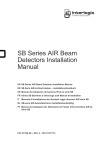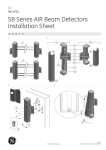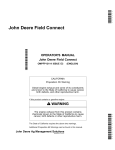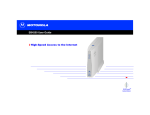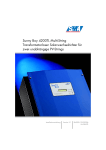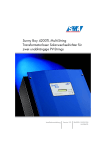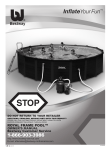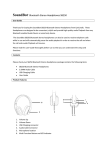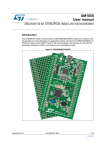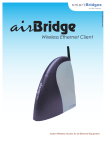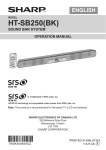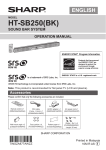Download SB Series AIR Beam Detectors Installation Manual
Transcript
SB Series AIR Beam Detectors Installation Manual EN SB Series AIR Beam Detectors Installation Manual DE Für eine deutsche Anleitung siehe www.utcfssecurityproducts.eu/manuals/NT299-ML_RevA_SB_Series.pdf ES Para manual en Español consultar www.utcfssecurityproducts.eu/manuals/NT299-ML_RevA_SB_Series.pdf FR Pour le manuel en Français voir www.utcfssecurityproducts.eu/manuals/NT299-ML_RevA_SB_Series.pdf IT Per il manuale in italiano vedere www.utcfssecurityproducts.eu/manuals/NT299-ML_RevA_SB_Series.pdf NL Voor de Nederlandse handleiding, gebruik deze link: www.utcfssecurityproducts.eu/manuals/NT299-ML_RevA_SB_Series.pdf PT Para Português ver www.utcfssecurityproducts.eu/manuals/NT299ML_RevA_SB_Series.pdf P/N NT299-EN • REV A • ISS 03JUL12 Copyright Trademarks and patents © 2012 UTC Fire & Security. All rights reserved. Interlogix, the SB Series AIR Beam Detectors name and logo are trademarks of UTC Fire & Security. Other trade names used in this document may be trademarks or registered trademarks of the manufacturers or vendors of the respective products. Manufacturer UTC Fire & Security Americas Corporation, Inc. 1275 Red Fox Rd., Arden Hills, MN 55112-6943, USA Authorized EU manufacturing representative: UTC Fire & Security B.V. Kelvinstraat 7, 6003 DH Weert, Netherlands Certification European Union directives 1999/5/EC (R&TTE directive): Hereby, UTC Fire & Security declares that this device is in compliance with the essential requirements and other relevant provisions of Directive 1999/5/EC. 2002/96/EC (WEEE directive): Products marked with this symbol cannot be disposed of as unsorted municipal waste in the European Union. For proper recycling, return this product to your local supplier upon the purchase of equivalent new equipment, or dispose of it at designated collection points. For more information see: www.recyclethis.info. Contact information Customer support www.utcfireandsecurity.com or www.interlogix.com www.interlogix.com/customer-support. Content Introduction 1 General features 2 Detector layout 3 Accessories supplied 3 Installation 4 General guidelines 4 Detector mounting 4 Removing the infrared cover 5 Wiring 6 DIP switch settings 7 Cable length 8 Alarm and disqualification relay 8 Connecting the tamper detection contact 9 Configuration 10 Channel selection 10 Operating modes 11 Single module alignment and settings 12 Installing modules in columns 15 Connections 15 Setting “Slave” mode 17 Module numbering 17 “Master” module selection 18 “Master” module channel selection 19 Detection mode selection 19 Mono-detection of the bottom beam (optional) 20 Column alignment 22 Response time 23 Replacing the infrared cover 24 Final tests 25 Maintenance 26 Troubleshooting 27 Specifications 29 Default configuration 30 Dimensions 30 Accessories and spare parts 31 SB Series AIR Beam Detectors Installation Manual i ii SB Series AIR Beam Detectors Installation Manual Introduction The SB250-N / SB2100-N two-beam detectors and the SB450-N / SB4100-N / SB4200-N four-beam detectors generate an alarm when 1 or 2 beams are interrupted, ignoring birds, small animals, dead leaves etc. They consist of two identical detector modules equipped with detector cells integrating both transmission and reception functions. These modules are installed facing each other over the distance to be protected providing a nonphysical invisible detection zone. Detectors are based on a system of pulsed infrared beams, and operate on four user-selectable frequencies (channels), which allow avoiding any risk of interference between detectors. The SB450-N and SB4100-N barriers have 2 operating modes suitable for different types of installation (see “Operating modes” on page 11): • “AND” mode: Simultaneous obstruction of two adjacent cells • “OR” mode: Obstruction of one of the cells Refer to “Installing modules in columns” on page 14 for detailed information on infrared barriers functionality in columns. SB Series AIR Beam Detectors Installation Manual 1 General features • Maximum outdoor range: - SB250-N : 50 m - SB2100-N : 100 m - SB450-N : 50 m - SB4100-N : 100 m - SB4200-N : 200 m The range of an infrared detector depends directly on visual range. Maximum range of an infrared cell according to visibility: - When visibility is 200 m, the range is 200 m. - When visibility is 60 m (dense fog), the range is 100 m. • Four user-selectable frequencies (channels) for distinguishing between different detectors. • SB250-N and SB2100-N detectors are equipped with one cell. • SB450-N, SB4100-N and SB4200-N type detectors are equipped with two cells dual-beam. • 2 operating modes for SB450-N and SB4100-N: “AND” and “OR”. • SB250-N, SB2100-N and SB4200-N have only 1 operating mode: “AND”. 2 SB Series AIR Beam Detectors Installation Manual Detector layout Figure 1: Detector layout (1) 2 cells module, type SB450-N / SB4100-N / SB4200-N (2) 1 cell module, type SB250-N / SB2100-N (3) Top plate (4) Infrared cover (5) Dual-beam cell (7) Terminal block (8) Horizontal direction locking screw (9) Chassis (10) Vertical cell alignment (11) Cover removal tampers (12) Fixing staple for infrared cover (6) Adjustable support Accessories supplied • 8X Ø3.9x13 screws for fixing to column • 1X Installation manual SB Series AIR Beam Detectors Installation Manual 3 Installation General guidelines See Figure 2 below. To install the detectors correctly, certain rules must be followed. • Do not place the detector on an unstable support (such as a mesh or a poorly fixed post). See item 1. • Do not position the module facing direct sunlight (item 2). • Make sure that no vegetation interrupt the cells (item 3). Figure 2: Potential causes of instability Detector mounting To attach the detectors to a metallic support, drill 4 holes measuring 3 mm and use the sheet metal screws provided. To fix the detectors to a wall, use appropriate screws and wall plugs for the type of wall (we recommend at least Ø5 x 30 screws). • Drill 4 holes and insert wall plugs. • Position the holes in the adjustable support over the wall plugs. Note: Rotate the module to be able to reach the screw holes in the adjustable support (see Figure 3 on page 5). 4 SB Series AIR Beam Detectors Installation Manual Figure 3: Wall mounting (1) 4 screws (2) Rear view of the adjustable bracket Removing the infrared cover See Figure 4 below. 1. Remove the screw attaching the infrared cover, taking care not to lose the staple (item 1). 2. Slide the cover upwards until it is stopped by the top plate (item 2). 3. Pull the cover outwards from the grooves in the chassis to remove it (item 3). Figure 4: Removing the infrared cover SB Series AIR Beam Detectors Installation Manual 5 Wiring We recommend that different power supplies are used for the module and heating. Note: When using guillotine connectors, put the wire in the connector, and then pull it out slightly so that it tightens. Figure 5: Terminals and controls Item Description (1) Top cell (2) Bottom cell (3) DIP switches Note Channel selection (1 and 2) Operating mode selection (3 to 5) (4) Delay adjustment An adjustment of the response time of the intrusion alarm (50 to 800 ms) (5) Selection button Select alignment mode Select cells in alignment mode (6) Alarm LED Intrusion alarm / disqualification (blinking) Level of the signal in alignment Table 1: Terminals Terminal Description 1 “+” Power 2 “−” Power 3 “+” Heating 6 SB Series AIR Beam Detectors Installation Manual Terminal Description 4 “−” Heating 5 NO intrusion relay 6 COM intrusion relay 7 NO disqualification relay 8 COM disqualification relay 9 A column synchronization [1] 10 B column synchronization [1] [1] See “Installing modules in columns” on page 14. DIP switch settings Table 2: DIP switch 1 to 2 - channel selection Switch 1 Switch 2 Function OFF OFF Channel 1 ON OFF Channel 2 OFF ON Channel 3 ON ON Channel 4 See “Channel selection” on page 10 for more details. Table 3: DIP switch 3 to 5 - operating modes Switch 3 Switch 4 Switch 5 Function OFF OFF ON Single module in “AND” mode OFF OFF OFF Single module in “OR” mode OFF ON OFF “Slave” mode with low beam enabled OFF ON ON “Slave” mode with low beam disabled ON OFF OFF “Master” mode with the mono detection column ON OFF ON “Master” mode with double detection column ON ON OFF Not used ON ON ON Not used See “Operating modes” on page 11 for more details. SB Series AIR Beam Detectors Installation Manual 7 Cable diameter and length Table 4: Length of 12V DC power cable (m) (screened SYT1-type) Ø of wire (mm) Cross-section area wire (mm²) SB250-N SB2100-N SB450-N SB4100-N SB4200-N 0,6 0,3 159 159 136 136 136 0,9 0,6 359 359 307 307 307 1,4 1,5 800 800 684 684 684 Table 5: Length of 12V AC/DC heating cable (m) (screened SYT1-type) Ø of wire (mm) Cross-section SB250-N area wire (mm²) SB2100-N SB450-N SB4100-N SB4200-N 0,6 0,3 94 94 47 47 47 0,9 0,6 211 211 105 105 105 1,4 1,5 470 470 235 235 235 Note: If a single cable is used to supply power to several elements, the distance given should be divided by the number of elements connected to the cable. If several wires of the same crosssectional area and polarity are placed in parallel, the distances given should be multiplied by the number of wires. Alarm and disqualification relay When infrared signal is significantly reduced (for example, fog, heavy rain, etc.) then the disqualification relay will be triggered after 60 s and the Alarm LED will blink. In case of obstruction of the beams (for example, by an object or a person) for more than 60 s, first alarm relay will be triggered, then disqualification relay will be triggered and alarm relay will be reset (see Figure 6 on page 9 for details). 8 SB Series AIR Beam Detectors Installation Manual Figure 6: Relay response Alarm condition Beam interruption Min 4 s Alarms relay Disqualification due to reduced infrared signal Reduced Infrared signal Alarm relay (NC) Max 60 s Disqualification relay (NO) [1] Disqualification due to obstruction by an object or person Beam interruption Max 60 s Alarm relay (NC) Disqualification relay (NO) [1] [1] This releases the alarm relay when there are several alarm relays connected in series (for example, different modules in one pillar). If this option is not required, connect the alarm and disqualification relays in series. Connecting the tamper detection contact Remove the PCB at the bottom of the module, connect the two wires and then replace the PCB sliding it in the two grooves until it can go no further, and taking care not to twist the contact strip. SB Series AIR Beam Detectors Installation Manual 9 Configuration Channel selection To avoid different detectors on the same site interfering with each other, they are equipped with 4 user-selectable frequencies (channels). Each of 2 modules composing the detection area must be set with the same number of channel. This configuration is done using DIP switches 1 and 2 on the top of the terminal block. The channel is validated once the detector is powered on. (Switching channels once the detector is powered up has no effect on the channel selection). Figure 7: Channel selection switches Channel 1 (OFF OFF) Channel 2 (ON OFF) Channel 3 (OFF ON) Channel 4 (ON ON) When the detectors are placed in the same alignment (see Figure 8 below), allocate different channels to each detector, channel 1 (item 1) to channel 3 (item 3). Figure 8: Multiple channels example (1) (1) Channel 1 10 (2) (1) Channel 2 (3) (1) Channel 3 SB Series AIR Beam Detectors Installation Manual When the detectors are placed one on the top of the other (see Figure 9 below), allocate the same channel to each detector and relay them to each other by the synchronization link in Column mode. Figure 9: Single channel example (1) (2) (2) (1) (1) Channel 1 (2) Inter-module connection Operating modes The SB450-N and SB4100-N barriers can operate in 2 modes: • “AND” mode: simultaneous obscuration of 2 dual-beam cells to trigger the intrusion alarm. • “OR” mode: obscuration of one of the dual-beam cells to trigger the intrusion alarm. The mode is selected with DIP switches 3 to 5. The DIP switch location is shown in Figure 5 on page 6. See Figure 10 on page 12 for modes illustration and DIP switch settings. Caution: The DIP switches settings must be identical on both of 2 associated modules. In OR mode, the response time must be also equal. SB Series AIR Beam Detectors Installation Manual 11 Figure 10: Operation modes “AND” mode: “OR” mode: Caution: Adjust the intrusion alarm response time by using the potentiometer as described in “Response time” on page 23. It will adapt the detection sensitivity of the barrier to the environment. A long response time decreases the sensitivity. Note: Mode selection is only available in all 2 cell modules beams (SB450-N and SB4100-N), except for the SB4200-N, which only supports the “AND” mode Caution: The selected operating mode is activated during barrier power-up. Any change of appropriate the DIP switch setting has no effect until the detector power supply is reconnected. Single module alignment and settings Optical alignment Figure 11: Optical alignment This alignment consists in lining up the optical axes of the modules installed facing each other. This basic alignment adjustment is performed for each module using the integrated sighting system. 12 SB Series AIR Beam Detectors Installation Manual Aligning the cells visually Figure 12: Visual alignment (1) Viewfinder (3) Oblique angle (2) Viewfinder image (4) Vertical adjustment thumbscrew To align the detector: 1. Slightly unscrew the module’s adjustable support. 2. Position your eye at an oblique angle about 5 cm from the module as shown in Figure 12, item 3. 3. Look in the mirror inside the module to see the image (item 2) of the module opposite through the viewfinder (item 1) in the side of the cell. - Horizontal alignment: Rotate the adjustable support by up to 90°. - Vertical alignment: Turn the thumbscrew (item 4) by up to 10°. Once the optimal alignment has been achieved, tighten the screw of the adjustable support to lock horizontal rotation. Optimization of the detector alignment (without module synchronization) Figure 13: Optimization of the detector alignment 1. Power cycle the unit (module) - The buzzer beeps 1 time for SB250-N and SB450-N. - The buzzer beeps 2 times for the SB2100-N and SB4100-N. - The buzzer beeps 3 times for the SB4200-N. SB Series AIR Beam Detectors Installation Manual 13 2. Hold down “Select” button (for at least 2 seconds) until the buzzer beeps 2 times. The red LED blinks once and the buzzer sounds one long beep to indicate the alignment of the bottom cell. 3. Rotate the cell until the buzzer sound becomes continuous and the alarm LED lights up continuously. - SB250-N, SB2100-N, SB450-N and SB4100-N: the alignment must be done cell by cell. - SB4200-N: the alignment most be done on both cells simultaneously. See “Alignment status indication” below for status indication details. 4. For the SB450-N and SB4100-N modules, switch to the next cell by pressing “Select” button. Blinks of the alarm LED and buzzer beeps are indicating the number of the cell to be aligned. Rotate the cell until the buzzer signal becomes continuous and the alarm LED lights up continuously. To exit from the alignment mode, hold down “Select” button for more than 2 seconds until the buzzer beeps 2 times. Alignment status indication Table 6: Alignment status indication Red LED status Buzzer status Alignment status Slow blink Slow beep Bad Quick blink Quick beep Good [1] Fixed light Continuous sound Excellent Note: In absence of a signal, the buzzer beeps one time per second. [1] The modules SB4200-N, if the continuous beep cannot be reached, try to obtain the quickest beep that is possible. 14 SB Series AIR Beam Detectors Installation Manual Installing modules in columns It is possible to combine up to 4 modules in one column. Table 7 below shows the compatibility of detector models in one column. Table 7: Detector models compatibility SB250-N SB450-N SB2100-N SB4100-N SB4200-N SB250-N Yes Yes No No No SB450-N Yes Yes No No No SB2100-N No No Yes Yes No SB4100-N No No Yes Yes No SB4200-N No No No No Yes We do not recommend mixing detectors of different generations (for example, SB250 and SB250-N) or brands in a same column. Connections Mount the modules as described in “Installation” on page 4. Connect the modules between themselves via the inter-module connections A and B (connect the A’s to the A’s and the B’s to the B’s). Recommendation: wire the alarm relays on the module 2 (the second module from the bottom of the column) because this module is recommended to be selected as “Master”. SB Series AIR Beam Detectors Installation Manual 15 Figure 14: Multiple module wiring (1) to (4) 16 Modules 1 to 4 (5) Inter-module connection SB Series AIR Beam Detectors Installation Manual Setting “Slave” mode Put all the modules in “Slave” mode: switch 3 on OFF and switch 4 on ON. Figure 15: Slave mode Caution: All the switch configurations of the modules of one column must be the same as the modules opposite on the other column that constitutes the barrier. Module numbering Determine positions of the modules inside a column. Note: The numbers designating the positions must follow from bottom to top. If there are less than 4 modules inside a column, there should not be gaps or overlaps in the numbering (see Table 8 below). Table 8: Allowed module numbering Position 1 Position 2 2 modules X X 3 modules X X X 4 modules X X X SB Series AIR Beam Detectors Installation Manual Position 3 Position 4 X 17 Figure 16: Module configuration “Master” module selection Set the module on which the relay alarms are wired in “Master” mode: switch 3 ON and switch 4 OFF. Caution: A column is composed of 1 “Master” module and 1 to 3 “Slave” modules. “Master” module can be positioned anywhere within the column: position 1, 2, 3 or 4. If “Master” is installed in position 1, it is not possible to use the mono-detection of the bottom beam (see “Mono-detection of the bottom beam (optional)” on page 20) for more details. Figure 17: “Master” mode selection 18 SB Series AIR Beam Detectors Installation Manual “Master” module channel selection Select the channel of the barrier on “Master” module (see also “Channel selection” on page 10). Figure 18: Master module channel selection Channel 1 (OFF OFF) Channel 2 (ON OFF) Channel 3 (OFF ON) Channel 4 (ON ON) Detection mode selection Select the detection mode: simple detection or interdetection (not available on the modules SB4200-N). The detection mode is set on the “Master” module: • Switch 5 of the “Master” module ON to select dual-detection. • Switch 5 of the “Master” module OFF to select simple detection. SB Series AIR Beam Detectors Installation Manual 19 Figure 19: Detection mode selection (A) Interdetection mode (5) “Master” module settings (B) Simple detection mode (6) Dual detection between modules (1) to (4) Modules 1 to 4 Important Note: Interdetection can be selected for all kind of modules except for SB4200-N (item 6). Mono-detection of the bottom beam (optional) Important Note: Functionality is not available in SB4200-N, SB250-N and SB2100-N modules. The column must be configured in interdetection mode in order to activate the mono-detection of the bottom beam. 20 SB Series AIR Beam Detectors Installation Manual The mono-detection of the bottom beam triggers an intrusion alarm when the bottom beam is cut for a period of 1.5s. The mono-detection of the bottom beam is activated on the “Slave” module in position 1 only. • Switch 5 of “Slave” module OFF to activate the mono-detection of the bottom beam. • Switch 5 of “Slave” module ON to deactivate the mono-detection of the bottom beam. Figure 20: Bottom beam mono-detection (A) Interdetection mode with mono detection (5) “Master” module settings (B) Interdetection mode without mono detection (6) Dual detection between modules (1) to (4) Modules 1 to 4 SB Series AIR Beam Detectors Installation Manual 21 Column alignment Alignment of the columns: start by aligning the cells with the integrated optical sight on each cell for each module (see “Single module alignment and settings” on page 12). Optimization of synchronized barriers alignment Figure 21: Optimization of synchronized barriers alignment (1) to (4) Modules 1 to 4 (A) to (H) Cells 1 to 8 1. Power cycle the modules in the barrier. - The buzzer beeps 1 time for SB250-N and SB450-N. - The buzzer beeps 2 times for the SB2100-N and SB4100-N. - The buzzer beeps 3 times for the SB4200-N. The red LED blinks for 5 to 10 s during the initialization of the column. 2. Press “Select” button of “Master” module (for at least 2 seconds) until the buzzer of “Master” module beeps twice. The red LED blinks once and the buzzer sounds one long beep on “Master” module to indicate the alignment of the bottom cell. 22 SB Series AIR Beam Detectors Installation Manual 3. Rotate and readjust the cell until the buzzer sounds a continuous beep and the red LED stays lit. Note: SB250-N, SB2100-N, SB450-N and SB4100-N are aligned cell by cell. SB4200-N is aligned module by module (two cells of the same module at the same time). See “Alignment status indication” on page 14 for status indication details. 4. Move on to the next cell by pressing “Select” button of “Master” module, the blinks of the red LED and the beeps of the buzzer indicate the number of the cell to be aligned. Rotate and readjust the cell until the buzzer sounds a continuous beep and the red LED stays lit. To leave the alignment mode, push “Select” button of “Master” module for more than 2 seconds until the buzzer beeps two times. Response time Set the response time of the intrusion alarm by using the potential-meter of “Master” module. This allows the sensitivity of the barrier to be adapted to its environment. A long response time reduces the sensibility of the barrier. (1) “Master” module (2) Potentiometer to set the response time of the intrusion alarm SB Series AIR Beam Detectors Installation Manual (3) Response time 23 Replacing the infrared cover Figure 22: Replacing the infrared cover 1. Engage the infrared cover in the grooves of the chassis taking care not to loose the staple (step 1). 2. Slide the cover upwards until it is stopped by the top plate (step 2). 3. Place it flat along the chassis, then slide it downwards and screw in the cover fixing screw (step 3). 24 SB Series AIR Beam Detectors Installation Manual Final tests After installation, make sure everything is working with an overall system test. SB250-N and SB2100-N barriers • • Movement control in the cell: intrusion alarm. Extended interruption of the cell for more than 1 minute: disqualification alarm. For SB4200-N barriers • • • Movement control in only one of the two cells: alarm not triggered. Movement control in both of two cells: intrusion alarm. Extended interruption of both cells for more than 1 minute: disqualification alarm. For SB450-N and SB4100-N barriers “AND” mode: • • • Movement control in only one of the two cells: alarm not triggered. Movement control in both of two cells: intrusion alarm. Extended interruption of both cells for more than 1 minute: disqualification alarm. “OR” mode: • • • Movement control on the top cell: intrusion alarm. Movement control in the lower cell: intrusion alarm. Extended interruption of one of the two cells for more than 1 min: disqualification alarm. Modules installed in columns Simple detection: • • Movement control in only one of the two cells: intrusion alarm. Extended interruption of one cell for more than 1 min: disqualification alarm. Interdetection: • • • • • Movement control in only one of the two cells: alarm not triggered. Movement control in both of two adjacent cells: intrusion alarm. Movement test on two adjacent cells on two different modules (except SB4200-N): intrusion alarm. Extended interruption of one of two cells for more than 1 min: disqualification alarm. If the bottom cell is enabled: Movement control in the bottom cell for more than 1.5 sec: intrusion alarm. SB Series AIR Beam Detectors Installation Manual 25 Maintenance To keep good ongoing performance levels, minimal maintenance is required: • Clean the infrared cover of each module at least once a year (or more often, depending on exposure to dirt). • Repeat the final tests (once a year). See “Final tests” on page 25. 26 SB Series AIR Beam Detectors Installation Manual Troubleshooting How to find the “Master” module Push the button “Select” for at least 2 seconds: • • The buzzer beeps two times: the module is “Master”. The buzzer does not sound: the module is “Slave”. All configurations Fault Possible cause Solution Red led blinks The 2nd module creating the detection zone is not powered Check the power supply of the 2nd module The modules creating the detection zone are using different channels Set both of associated modules on the same channel Poor cell alignment Repeat the alignment procedure Cells are covered or in disqualification Clear cells field of view Incorrect power supply of the module Check power supply The red alarm LED does not light up when the beams are interrupted Both cell beams are not Break all cell beams at the interrupted simultaneously (for same time SB450-N, SB4100-N and SB4200-N barriers only) The red alarm LED does not light up when only one beam is interrupted Modules in “AND” mode Put module in “OR” mode. See “Operating modes” on page 11 for more details. Red LED remains lit for more than 1 minute Factory-set configuration mode Set DIP switches 3 and 4. Fault Possible cause Solution Red LED: 1 flash light Module is in “Master” or “Slave” mode Turn off the selected mode. See “Operating modes” on page 11 for more details. Single modules only SB Series AIR Beam Detectors Installation Manual 27 Modules installed in columns only Observed fault Possible cause Red LED: 1 flash light Error in modules settings: 28 Solution Several “Master” modules are set up Verify DIP switches 3 to 5 settings. See “Installing modules in columns” on page 14 for more details. No “Master” module is set up Set up one of the “Master” modules with the switches 1 and 2. See “Installing modules in columns” on page 14 for more details. The position of “Slave” is not correct Check the position of “Slave” modules with switches 1 and 2. See “Installing modules in columns” on page 14 for more details. Inter-module connection fault Wire the inter-module connections. See “Installing modules in columns” on page 14 for more details. Mixing of installed ranges. Verify the compatibility of modules. Put the modules of the same range only. See Table 7 on page 15 for more details. SB Series AIR Beam Detectors Installation Manual Specifications Detector model SB250-N SB2100-N SB450-N SB4100-N SB4200-N Maximum protected distance for interior use 125 m 250 m 125 m 250 m 350 m Maximum protected distance for outdoor use with thermostat controlled heating 50 m 100 m 50 m 100 m 200 m [1] Type of detection Pulsed infrared beam of wavelength 950 nm at a choice of 4 channels Number of cells 1 cell Detection mode Cell is interrupted Intrusion alarm response time 2 cells 60 s, non-adjustable Duration of cell interruption, with a minimum of 4 seconds Power supply Current consumption at 12 VDC (1 module) 10 to 15 VDC 47 mA 47 mA Heater power supply Heater current consumption at 12 VDC (1 module) 55 mA 55 mA 55 mA 160 mA 160 mA 10 to 15 V AC/DC 80 mA 80 mA 160 mA Intrusion output for each switch NC alarm off Yes Tamper output for each switch NC alarm off Yes Disqualification output for each switch NO alarm off Yes (cutting the intrusion alarm) Intrusion alarm output rating 30 VDC, 500 mA Tamper output rating 30 VDC, 500 mA Disqualification alarm output rating 30 VDC, 500 mA Operating temperature with thermostat controlled heating −25 to +55°C Protection rating Weight Both cells are interrupted Adjustable from 50 to 800 ms Disqualification alarm response time Typical duration of intrusion alarm 1 or 2 cells are interrupted. See “Single module alignment and settings” on page 12 for more details. IP44 0,8 kg Cell direction adjustability SB Series AIR Beam Detectors Installation Manual 0,9 kg 1,1 kg 1,2 kg 1,2 kg Vertically ±10° 29 Detector model SB250-N Module direction adjustability Integrated alignment tools SB2100-N SB450-N SB4100-N SB4200-N Horizontally ±90° Optical viewfinder system, LED, and buzzer indicating the quality of the received signal [1] Depends on visibility. See “General features” on page 2 for more details. Default configuration For modules default settings see figure 23. Modules are in “AND” mode by default. Figure 23: DIP switch default setting Dimensions All dimensions are given in mm. Figure 24: Detector dimensions 30 SB Series AIR Beam Detectors Installation Manual Accessories and spare parts Accessories • • • • SB53: Floor socket SB51: Alignment Controller SB52: Power Supply SB18: Anti-climbing Cap Spare parts • • • • • • • • SB12: Cover for column 1m SB17: Cover for column 1m50 SB22: Cover for column 2m SB27: Cover for column 2m50 SB32: Cover for column 3m SB13: Cover for module SB2XX SB14: Cover for module SB4XX SB19: Flask bottom and top + tamper card + cable glands SB Series AIR Beam Detectors Installation Manual 31 32 SB Series AIR Beam Detectors Installation Manual




































